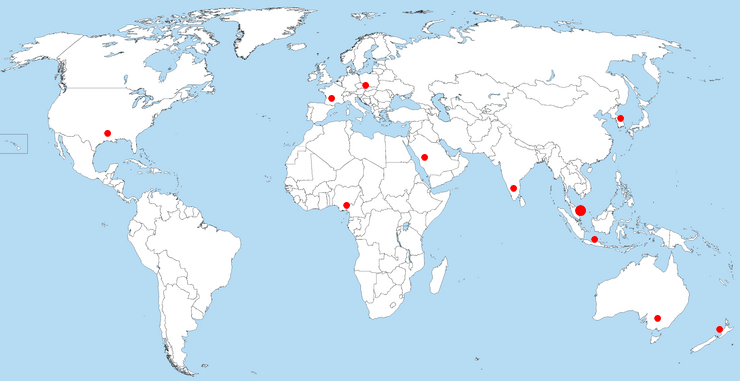Evaluation of Drag and Lift Forces of Grooved Cylinders in Wind Tunnel
Keywords:
Flow around cylinder, grooved cylinder, Reynolds number, smoke visualization, wind tunnel testAbstract
It is shown that surface modifications on surface of a circular cylinder affects the separation point to move backward on the cylinder surface hence reducing the drag coefficient. The flow past a circular cylinder with smooth, half and full rectangular grooved surface (roughness coefficient k/D = 0.004) was investigated in a low speed open end wind tunnel. The outer diameter(D) of the cylinders is 50mm and the depth(k) of the groove is 2mm. The Reynolds number used in the study ranges from 1.65 ×104 to 1.13 ×105. The drag and lift coefficients of the cylinders were measured using a three-component balance. The wake flow pattern of the cylinders was observed based on a smoke visualization technique. The results showed that the full-grooved cylinder and the half-grooved cylinder facing the flow (front) produce lower drag compared to a smooth cylinder and half-grooved cylinder located at the leeside of the flow (rear). The presence of the grooves on the cylinder surface affects the boundary layer and shows a smaller and narrower wake compared to a smooth cylinder.References
Butt U.and Egbers C., 2013. Aerodynamic Characteristics of Flow over Circular Cylinders with Patterned Surface,International Journal of Materials, Mechanics and Manufacturing, 1(2): 121-125.
Guven O., Farell C. and Patel V.C., 1980. Surface-roughness Effects on the Mean Flow Past Circular Cylinders,Journal of Fluid Mechanics, 98(4): 673-701.
Bearman P.W.and Harvey J.K., 1993. Control of Circular Cylinder Flow by the Use of Dimples, AIAA Journal,31(10): 1753.
Zhou B., Wang X., Guo W., Gho W.M. and Tan S.K.,2015. Experimental Study on Fl ow Past a Circular Cylinder with Rough Surface, Ocean Engineering, 109: 7–13.
Dandan M.A., Samion S., Musa M.N. and Zawawi F.M., 2019. Evaluation of Lift and Drag Force of Outward Dimple Cylinder Using Wind Tunnel, CFD Letters, 11(3): 145-153.
Song X., Qi Y., Zhang M., Zhang G. and Zhan W., 2019. Application and Optimization of Drag Reduction Characteristics on the Flow Around a Partial Grooved Cylinder by Using the Response Surface Method,Engineering Applications of Computational Fluid Mechanics, 13(1):158-176.
Kimura T.and Tsutaharat M., 1991. Fluid Dynamic Effects of Grooves on Circular Cylinder Surface, AIAA Journal, 29(12): 2062–2068.
Yamagishi Y. and Oki M., 2004. Effect of Groove Shape on Fluid Flow around a Circular Cylinder with Grooves, Journal of Visualization, 7: 209–216.
Quintavalla S.J., Angilella A.J. and Smits A.J., 2013. Drag Reduction on Grooved Cylinders in the Critical Reynolds Number Regime, Experimental Thermal and Fluid Science, 48: 15–18.
Doreti L.K. and Dineshkumar L., 2018. Control Techniques in Flow Past a Cylinder- A Review, IOP Conferenc Series Material Science Engineering, 377: 12144.
Lim H.and Lee S.J, 2002. Flow Control of Circular Cylinders with Longitudinal Grooved Surfaces,AIAA Journal,40(10): 2027-2036.
Huang S., 2010. Cylinder Drag Reduction by the Use of Helical Grooves, Proceedings of the HYDRALAB III Joint User Meeting, Hannover, 2005–2008.
Schlichting H. and Gersten K., 2016. Boundary-layer Theory, Springer.
Çengel Y.A. and Cimbala J.M., 2013. Fluid Mechanics: Fundamentals and Applications, McGraw-Hill Education.
Downloads
Published
How to Cite
Issue
Section
License
Copyright of articles that appear in Jurnal Mekanikal belongs exclusively to Penerbit Universiti Teknologi Malaysia (Penerbit UTM Press). This copyright covers the rights to reproduce the article, including reprints, electronic reproductions or any other reproductions of similar nature.






